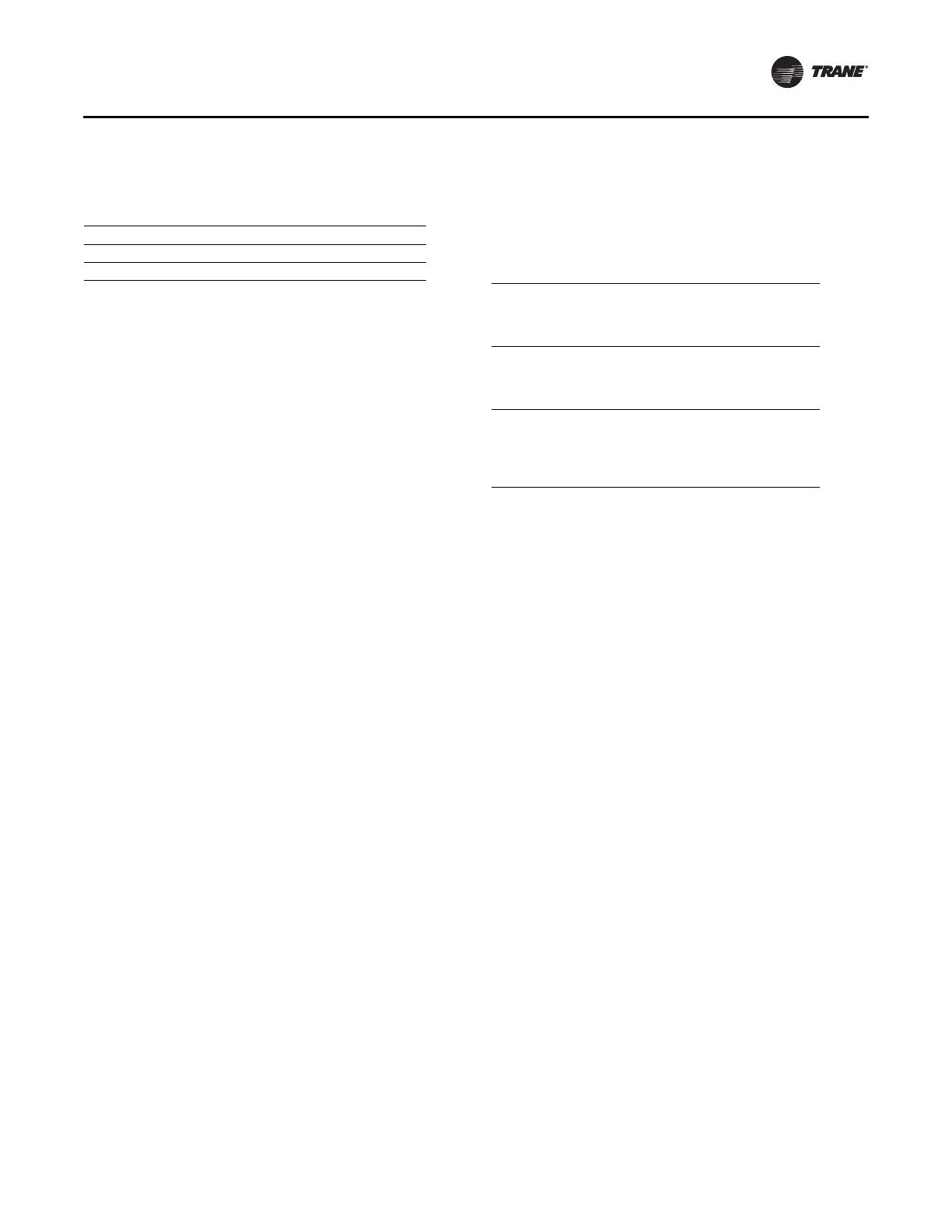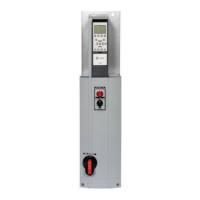Plumbing
AFDK-SVU01C-EN 33
should match power requirements on the assembly
nameplate in accordance with local codes (refer to
Table 13).
Table 13. Heat exchanger power requirements
Heat Exchanger FLA Volts/Phase/Hz
020600900100 3 A 460/3/60
020600910100 5.1 A 460/3/60
5. Wire the customer remote contact connection to the
pump control relay in the drive enclosure. This
connection gives the drive control of the cooling
assembly (refer to “Standard Control Wiring,” p. 38,
for AFDK term
ination location and requirements).
6. Fill the reservoir tank throu
gh the
manual fill port to a
level between the two black indicators on the sight
glass. The process fluid in the primary cooling loop
should be distilled water treated with an inhibitor
solution. For a more detailed description of process
fluids including addition of inhibitor solution, refer to
“Corrosion,” p. 33 and associated table from p. 104 of
Op
eratio
n and Maintenance: Liquid Cooled Adaptive
Frequency™ Drive (AFDB-OM-1C).
7. Turn the control switch to “on” position. The
circulatin
g pump and fan should begin rotation. Verify
the fan draws air through the coil.
8. Continue circulating pump for
five minutes to
allow air
in system to be vented.
9. Ensure all process fluid lines and shutoff valves are
open and the
system is able to flow freely. Re-check the
fluid level in the system before continuing with the
startup and note start-up pressure on fluid ports as a
baseline.
Corrosion
The heat exchanger used in the application is stainless
steel which is resistant to pitting and micro-galvanic
corrosion in most conditions of operation. However, one
can never do enough to completely prevent corrosion.
Therefore, we have provided guidelines for water quality
that would minimize the risk of corrosion and fouling.
Important: The hea
t exchanger
and components of the
cooling loops must be cleaned and rinsed
without fail immediately after shutdown.
In addition, corrosion of copper components can be
reduced if the
pH of the water is main
tained between 7.5
and 9.0, oxygen content is maintained below 0.1 ppm.
Compounds such as hydrog
en sulfide, ammonia, and
compounds with chlorides must be avoided at all costs in
the cooling loops. Water containing hydrazine is very
good for prevention of corrosion of iron and copper.
Note: Amm
oni
a cannot be used in cooling tower water
for this application.
Recommended concentration limits for impurities in
water to preve
nt micro-galvanic corrosion of unalloyed or
galvanized iron is included in Table.
Note: The
se values ar
e only recommended values and
cannot be considered as guarantees. Consult water
quality specialists for ultimate authority.
Table 14. Concentration limits of impurities in water
Ph
SO
4
-
Total hardness
Fe
3+
7.5–9.0
<90 ppm
4.0–8.0 dH
<0.3 ppm
H
2
S
PO
4
3
NH
3
HCO
3
-/SO
4
<50 ppb
<2.0 ppm
<0.5 ppm
>1.25
Cl-
Temperature
Oxygen content
Total dissolved solids
Free chlorine
<100 ppm
<45°C
<0.1 ppm
500 ppm of CaCO3
<0.4 ppm
Maintenance
Proper maintenance is the key to extending the life of the
unit. Establish a regular schedule of maintenance
depending on the amount of use and the environment.
Units that are within environments that are very dirty or
dusty will require more attention.
1. The process fluid should be clean and free of
co
ntaminan
ts. Check for debris or contaminants in the
reservoir which could reduce the efficiency.
2. Fluid filters should be clean to allow for proper flow
a
nd
pressure in the system. An increased fluid
pressure on the system may indicate a dirty filter.
Replacement of fluid filters should be done at regular
intervals to keep the fluid system clean and free
flowing. Inspect fluid filters shortly after initial start-up
of the chiller and to establish a baseline.
3. A proper fluid level (between
the indicators on sight
glass) should be maintained in the reservoir at all
times. Visually check for fluid leaks throughout
system.
4. Water-to-water heat excha
nger
s equipped with
cleanable exchangers are supplied with pressure
gauges on the IN and OUT fluid ports. Note normal PSI
at start-up and document as baseline (7–20 psi is
normal, de
pending on design).
Note: If the pressure increases from startup pressure
by more th
an 5 psi, the heat exchanger requires
service.
5. Water-to-air heat exchangers may require cleaning on
a
perio
dic basis. To clean, blow compressed air or
steam in a reverse direction through the coil.

